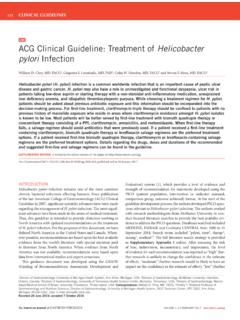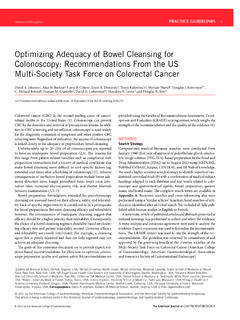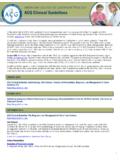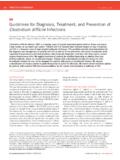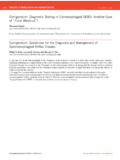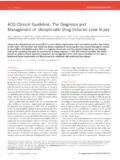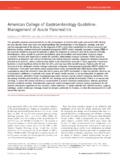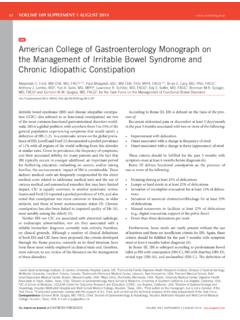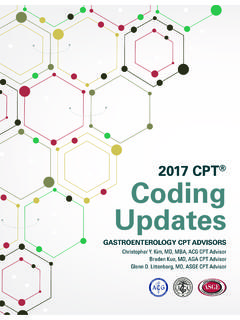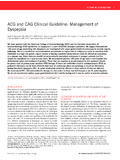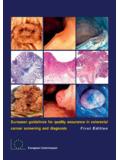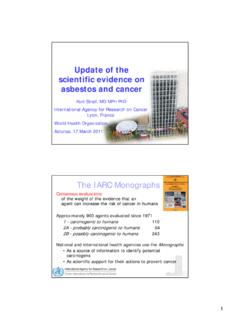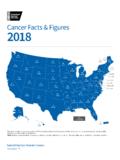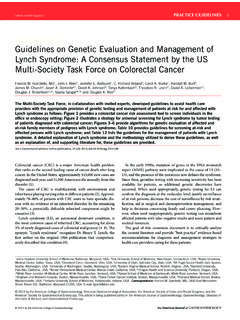Transcription of Colorectal Cancer Screening: Recommendations for ...
1 CLINICAL GUIDELINES 1. Colorectal Cancer Screening: Recommendations for Physicians and Patients from the Multi-Society Task Force on Colorectal Cancer Douglas K. Rex, MD1, C. Richard Boland, MD2, Jason A. Dominitz, MD, MHS3, Francis M. Giardiello, MD4, David A. Johnson, MD5, Tonya Kaltenbach, MD6, Theodore R. Levin, MD7, David Lieberman, MD8 and Douglas J. Robertson, MD, MPH9. This document updates the Colorectal Cancer (CRC) screening Recommendations of the Multi-Society Task Force of Colorectal Cancer (MSTF), which represents the American College of Gastroenterology, the American Gastroenterological Association, and The American Society for Gastrointestinal Endoscopy. CRC screening tests are ranked in 3 tiers based on performance features, costs, and practical considerations.
2 The rst-tier tests are colonoscopy every 10 years and annual fecal immunochemical test (FIT). Colonoscopy and FIT are recommended as the cornerstones of screening regardless of how screening is offered. Thus, in a sequential approach based on colonoscopy offered rst, FIT should be offered to patients who decline colonoscopy. Colonoscopy and FIT are recommended as tests of choice when multiple options are presented as alternatives. A risk-strati ed approach is also appropriate, with FIT screening in populations with an estimated low prevalence of advanced neoplasia and colonoscopy screening in high prevalence populations. The second-tier tests include CT colonography every 5 years, the FIT-fecal DNA test every 3 years, and exible sigmoidoscopy every 5 to 10 years.
3 These tests are appropriate screening tests, but each has disadvantages relative to the tier 1 tests. Because of limited evidence and current obstacles to use, capsule colonoscopy every 5 years is a third-tier test. We suggest that the Septin9. serum assay (Epigenomics, Seattle, Wash) not be used for screening. Screening should begin at age 50 years in average-risk persons, except in African Americans in whom limited evidence supports screening at 45 years. CRC. incidence is rising in persons under age 50, and thorough diagnostic evaluation of young persons with suspected Colorectal bleeding is recommended. Discontinuation of screening should be considered when persons up to date with screening, who have prior negative screening (particularly colonoscopy), reach age 75 or have <10 years of life expectancy.
4 Persons without prior screening should be considered for screening up to age 85, depending on age and comorbidities. Persons with a family history of CRC or a documented advanced adenoma in a rst-degree relative age <60 years or 2 rst-degree relatives with these ndings at any age are recommended to undergo screening by colonoscopy every 5 years, beginning 10 years before the age at diagnosis of the youngest affected relative or age 40, whichever is earlier. Persons with a single rst-degree relative diagnosed at 60 years with CRC or an advanced adenoma can be offered average-risk screening options beginning at age 40 years. Am J Gastroenterol advance online publication, 6 June 2017; Colorectal Cancer (CRC) screening is the process of detecting Association, and the American Society for Gastrointestinal early-stage CRCs and precancerous lesions in asymptomatic peo- Endoscopy.
5 The MSTF, like others, has long endorsed systematic ple with no prior history of Cancer or precancerous lesions. The offers of CRC screening to average-risk persons (persons without Multi-Society Task Force of Colorectal Cancer (MSTF) is a a high-risk family history of Colorectal neoplasia) beginning at age panel of expert gastroenterologists representing the American 50 years, with general evidence supporting screening reviewed in College of Gastroenterology, the American Gastroenterological previous publications (1). This publication updates the screen- 1. Indiana University School of Medicine, Indianapolis, Indiana, USA; 2 University of California San Diego, San Diego, California, USA; 3VA Puget Sound Health Care System, University of Washington, Seattle, Washington, USA; 4 Johns Hopkins University School of Medicine, Baltimore, Maryland, USA; 5 Eastern Virginia Medical School, Norfolk, Virginia, USA; 6 San Francisco Veterans Affairs Medical Center, San Francisco, California, USA; 7 Kaiser Permanente Medical Center, Walnut Creek, California, USA; 8 Oregon Health and Science University, Portland, Oregon, USA; 9VA Medical Center, White River Junction, Vermont, and Geisel School of Medicine at Dartmouth, Hanover, New Hampshire, USA.
6 Correspondence: Douglas K. Rex, MD, Indiana University Hospital 4100, 550 N University Blvd, Indianapolis, IN 46202, USA. E-mail: 2017 by the American College of Gastroenterology The American Journal of GASTROENTEROLOGY. 2 Rex et al. ing Recommendations of the MSTF for screening in average-risk patients. Weak Recommendations are those where patient values persons (1). and preferences might play a larger role than the quality of evi- Screening differs from surveillance. Surveillance refers to the dence. Within the document we preface strong Recommendations interval use of colonoscopy in patients with previously detected with phrases such as we recommend and weak recommenda- CRC or precancerous lesions and interval colonoscopy in patients tions with we suggest.
7 Performed to detect dysplasia in persons with inflammatory bowel disease affecting the colon. Surveillance Recommendations from the MSTF on surveillance after Cancer (2) and removal of pre- APPROACHES TO SCREENING. cancerous lesions (3) are available in other documents. Screening In the United States CRC screening usually results from an office- is also distinct from diagnostic examinations, which refer to the based interaction between a healthcare provider and patient. investigation of patients with symptoms or positive screening tests Screening in this setting is termed opportunistic (4). other than colonoscopy. Colonoscopy is generally the test of choice Programmatic screening (sometimes called organized screening). for diagnostic examinations. refers to a system-wide, organized approach to offering screening to a population or members of a healthcare plan (4).
8 Programmatic screening has potential advantages over opportunistic screening, METHODS including systematic offers of screening, reduction of overscreen- Literature review ing, superior monitoring of quality, and systematic follow-up The English language medical literature using MEDLINE (2005 of testing. National CRC screening programs in Europe (5) and to August 1, 2016), EMBASE (2005 to third quarter 2016 update), Australia (6) use fecal occult blood testing and include screening the Database of Abstracts of Reviews and Effects (2005 to third colonoscopy in Germany and Poland (5). The United States has quarter 2016 update), and the Cochrane Database of Systematic no national program for CRC screening, although several large Reviews (2005 to third quarter 2014 update) was searched.
9 In healthcare plans offer programmatic screening, typically with a MEDLINE, subject headings for Colorectal Cancer screening were fecal immunochemical test (FIT) (7). Despite the potential advan- combined with headings for fecal occult blood test, fecal immu- tages of programmatic screening, the United States has achieved nochemical test, colonoscopy, sigmoidoscopy, CT colonoscopy, the world's highest rates of CRC screening compliance at 60%. fecal DNA, serum testing, cost-effectiveness, and quality. Similar and the greatest CRC incidence and mortality reduction, using an searches were performed in EMBASE, the Database of Abstracts almost entirely opportunistic approach (8 12). Incidence reduc- of Reviews and Effects, and the Cochrane Database of System- tions in the United States were 3 to 4% per year and 30% overall atic Reviews.
10 Case reports and studies performed in patients with in the first decade of this century (11,12). High rates of screening inflammatory bowel disease, prior CRC or polyps, or hereditary in the United States may reflect widespread awareness of CRC and CRC syndromes were excluded. Review papers, meta-analyses, insurance coverage of screening. The MSTF anticipates growth of gastroenterology textbooks, and editorials were searched manu- programmatic screening within healthcare systems but expects at ally for additional pertinent references. The review includes studies least short-term continued reliance on opportunistic screening in published since 2008 but also incorporates older evidence used the United States. Reliance on opportunistic screening can affect to draft the 2008 Recommendations (1).
